 Technology peripherals
Technology peripherals
 AI
AI
 If you want to learn artificial intelligence, you must master this data set. Introduction and practical use of MNIST
If you want to learn artificial intelligence, you must master this data set. Introduction and practical use of MNIST
If you want to learn artificial intelligence, you must master this data set. Introduction and practical use of MNIST
Learning artificial intelligence inevitably requires some data sets. For example, artificial intelligence for identifying pornography requires some similar pictures. Artificial intelligence for speech recognition and corpus are indispensable. Students who are new to artificial intelligence often worry about data sets. Today we will introduce a very simple, but very useful data set, which is MNIST. This data set is very suitable for us to learn and practice artificial intelligence-related algorithms.
The MNIST data set is a very simple data set produced by the National Institute of Standards and Technology (NIST). So what is this data set about? It's actually some handwritten Arabic numerals (ten numbers from 0 to 9).

#NIST is still very serious when producing data sets. The training set in the data set consists of handwritten digits from 250 different people, 50% of which are high school students and 50% of which are staff from the Census Bureau. The test set is also the same proportion of handwritten digit data.
How to download the MNIST data set
The MNIST data set can be downloaded from its official website (http://yann.lecun.com/exdb/mnist/). Since it is a foreign website, the download may be difficult. slow. It contains four parts:
- Training set images: train-images-idx3-ubyte.gz (9.9 MB, 47 MB after decompression, contains 60,000 samples)
- Training Set labels: train-labels-idx1-ubyte.gz (29 KB, 60 KB unzipped, contains 60,000 labels)
- Test set images: t10k-images-idx3-ubyte.gz (1.6 MB, unzipped 7.8 MB after decompression, containing 10,000 samples)
- Test set labels: t10k-labels-idx1-ubyte.gz (5KB, 10 KB after decompression, containing 10,000 labels)
The above contains two types of content, one is pictures and the other is labels. Pictures and labels correspond one to one. But the picture here is not the picture file we usually see, but a binary file. This dataset stores 60,000 images in a binary format. The label is the real number corresponding to the picture.
As shown in the figure below, this article downloads the data set locally and decompresses the result. For ease of comparison, the original compressed package and the decompressed files are included.

A brief analysis of the format of the data set
Everyone has discovered that after decompression, the compressed package is not a picture, but each compressed package corresponds to a independent question. In this file, information about tens of thousands of pictures or tags is stored. So how is this information stored in this file?
In fact, the official website of MNIST gives a detailed description. Taking the image file of the training set as an example, the file format description given by the official website is as follows:

As can be seen from the above figure, the first four 32-digit numbers are the training set description information. The first is the magic number, which is a fixed value of 0x0803; the second is the number of pictures, 0xea60, which is 60000; the third and fourth are the size of the picture, that is, the picture is 28*28 pixels. The following describes each pixel in one byte. Since one byte is used to describe a pixel in this file, you can know that the value of a pixel can be from 0 to 255. Where 0 means white and 255 means black.
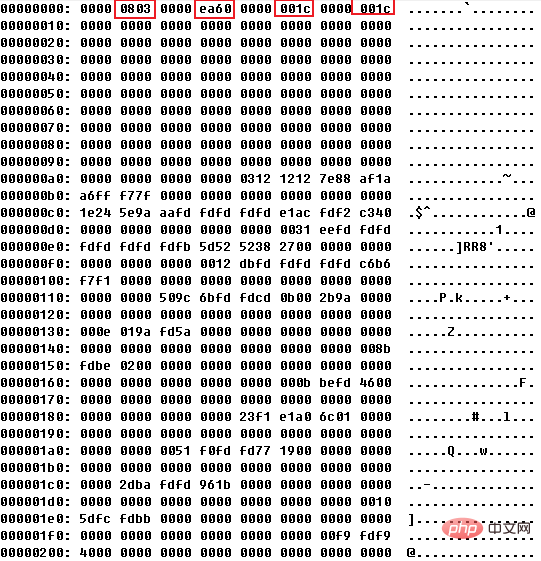
The format of tag files is similar to that of image files. There are two 32-digit numbers in front, the first of which is the magic number, fixed value 0x0801; the second one is used to describe the number of tags. The next data is the value of each tag, represented by one byte. The range of values represented here is
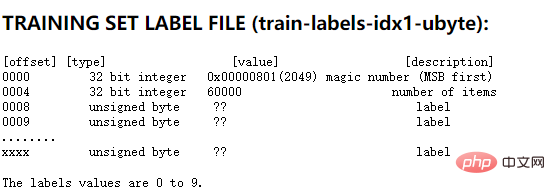
#The data of the label file corresponding to the actual training set is as follows. It can be seen that it is consistent with the description of the above format. In addition, we can see that corresponding to this label set, the numbers represented by the previous pictures should be 5, 0, 4, 1, etc. respectively. Remember it here, it will be used later.
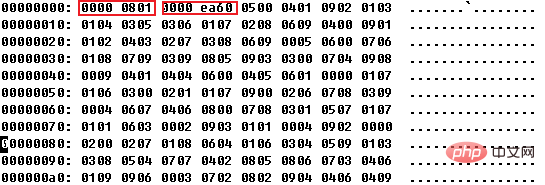
We know about the file format of the data set, let’s do it in practice.
Visual processing of data sets
After knowing the storage format of the above data, we can parse the data. For example, the following article implements a small program to parse a picture in the picture collection and obtain visual results. Of course, we can actually know what the picture is based on the value of the label set. This is just an experiment. The final result is stored in a text file, using the character "Y" to represent the handwriting and the character "0" to represent the background color. The specific program code is very simple and will not be described in detail in this article.
# -*- coding: UTF-8 -*-
def trans_to_txt(train_file, txt_file, index):
with open(train_file, 'rb') as sf:
with open(txt_file, "w") as wf:
offset = 16 + (28*28*index)
cur_pos = offset
count = 28*28
strlen = 1
out_count = 1
while cur_pos < offset+count:
sf.seek(cur_pos)
data = sf.read(strlen)
res = int(data[0])
#虽然在数据集中像素是1-255表示颜色,这里简化为Y
if res > 0 :
wf.write(" Y ")
else:
wf.write(" 0 ")
#由于图片是28列,因此在此进行换行
if out_count % 28 == 0 :
wf.write("n")
cur_pos += strlen
out_count += 1
trans_to_txt("../data/train-images.idx3-ubyte", "image.txt", 0)When we run the above code, we can get a file named image.txt. You can see the contents of the file as follows. The red notes were added later, mainly for better visibility. As you can see from the picture, this is actually a handwritten "5".
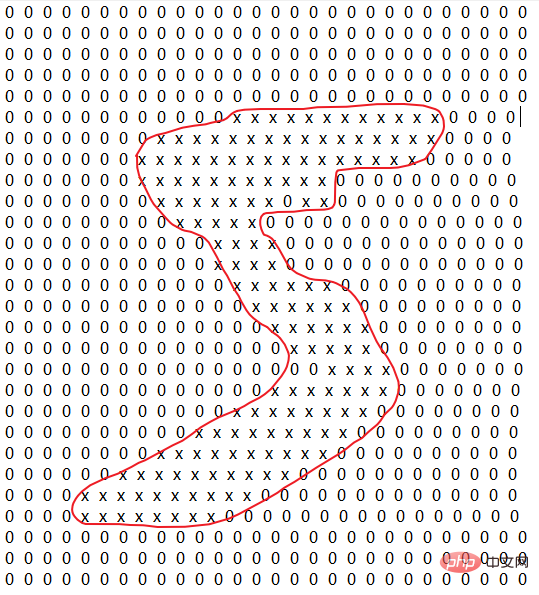
# Previously we visually analyzed the data set through the native Python interface. Python has many already implemented library functions, so we can simplify the above functions through a library function.
Parsing data based on third-party libraries
It is slightly complicated to implement using the native Python interface. We know that Python has many third-party libraries, so we can use third-party libraries to parse and display the data set. The specific code is as follows.
# -*- coding: utf-8 -*-
import os
import struct
import numpy as np
# 读取数据集,以二维数组的方式返回图片信息和标签信息
def load_mnist(path, kind='train'):
# 从指定目录加载数据集
labels_path = os.path.join(path,
'%s-labels.idx1-ubyte'
% kind)
images_path = os.path.join(path,
'%s-images.idx3-ubyte'
% kind)
with open(labels_path, 'rb') as lbpath:
magic, n = struct.unpack('>II',
lbpath.read(8))
labels = np.fromfile(lbpath,
dtype=np.uint8)
with open(images_path, 'rb') as imgpath:
#解析图片信息,存储在images中
magic, num, rows, cols = struct.unpack('>IIII',
imgpath.read(16))
images = np.fromfile(imgpath,
dtype=np.uint8).reshape(len(labels), 784)
return images, labels
# 在终端打印某个图片的数据信息
def print_image(data, index):
idx = 0;
count = 0;
for item in data[index]:
if count % 28 == 0:
print("")
if item > 0:
print("33[7;31mY 33[0m", end="")
else:
print("0 ", end="")
count += 1
def main():
cur_path = os.getcwd()
cur_path = os.path.join(cur_path, "..data")
imgs, labels = load_mnist(cur_path)
print_image(imgs, 0)
if __name__ == "__main__":
main()The above code is divided into two steps. The first step is to parse the data set into an array, and the second step is to display a certain picture in the array. The display here is also through a text program, but it is not stored in a file, but printed on the terminal. For example, if we still print the first picture, the effect is as follows:
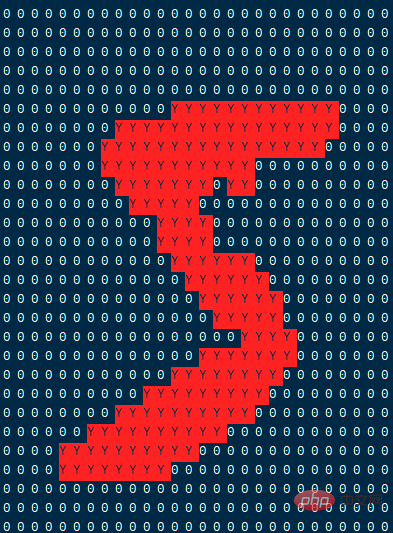
The presentation of the above results only simulates the picture through characters. In fact, we can use third-party libraries to achieve more perfect image presentation. Next, we introduce how to present pictures through the matplotlib library. This library is very useful, and I will come into contact with this library later.
We implement a
def show_image(data, index): fig, ax = plt.subplots(nrows=1, ncols=1, sharex=True, sharey=True, ) img = data[0].reshape(28, 28) ax.imshow(img, cmap='Greys', interpolation='nearest') ax.set_xticks([]) ax.set_yticks([]) plt.tight_layout() plt.show()
At this point you can see that
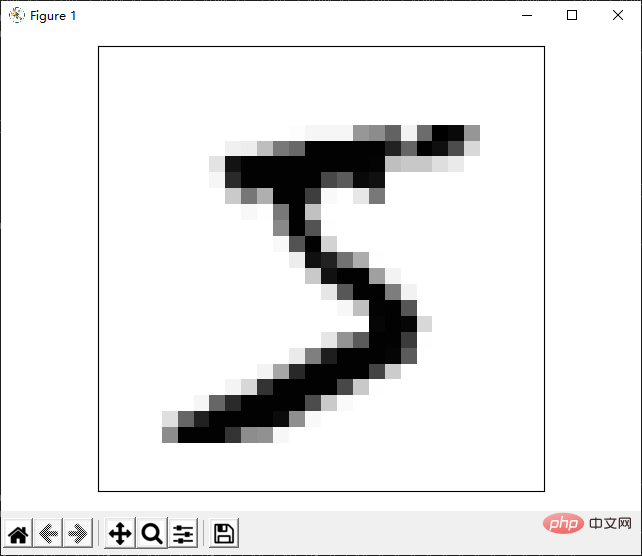
There may be some third-party libraries missing when implementing the above functions, such as matplotlib etc. At this time, we need to install it manually. The specific method is as follows:
pip install matplotlib -i http://pypi.douban.com/simple/ --trusted-host pypi.douban.com
Data analysis based on TensorFlow
MNIST is so famous that TensorFlow already supports it. Therefore, we can load and parse it through TensorFlow. Below we give the code implemented with TensorFlow.
# -*- coding: utf-8 -*-
from tensorflow.examples.tutorials.mnist import input_data
import pylab
def show_mnist():
# 通过TensorFlow库解析数据
mnist = input_data.read_data_sets("../data", one_hot=True)
im = mnist.train.images[0]
im = im.reshape(28 ,28)
# 进行绘图
pylab.imshow(im, cmap='Greys', interpolation='nearest')
pylab.show()
if __name__ == "__main__":
show_mnist()The final effect achieved by this code is the same as the previous example, so I won’t go into details here.
The above is the detailed content of If you want to learn artificial intelligence, you must master this data set. Introduction and practical use of MNIST. For more information, please follow other related articles on the PHP Chinese website!

Hot AI Tools

Undresser.AI Undress
AI-powered app for creating realistic nude photos

AI Clothes Remover
Online AI tool for removing clothes from photos.

Undress AI Tool
Undress images for free

Clothoff.io
AI clothes remover

AI Hentai Generator
Generate AI Hentai for free.

Hot Article

Hot Tools

Notepad++7.3.1
Easy-to-use and free code editor

SublimeText3 Chinese version
Chinese version, very easy to use

Zend Studio 13.0.1
Powerful PHP integrated development environment

Dreamweaver CS6
Visual web development tools

SublimeText3 Mac version
God-level code editing software (SublimeText3)

Hot Topics
 Bytedance Cutting launches SVIP super membership: 499 yuan for continuous annual subscription, providing a variety of AI functions
Jun 28, 2024 am 03:51 AM
Bytedance Cutting launches SVIP super membership: 499 yuan for continuous annual subscription, providing a variety of AI functions
Jun 28, 2024 am 03:51 AM
This site reported on June 27 that Jianying is a video editing software developed by FaceMeng Technology, a subsidiary of ByteDance. It relies on the Douyin platform and basically produces short video content for users of the platform. It is compatible with iOS, Android, and Windows. , MacOS and other operating systems. Jianying officially announced the upgrade of its membership system and launched a new SVIP, which includes a variety of AI black technologies, such as intelligent translation, intelligent highlighting, intelligent packaging, digital human synthesis, etc. In terms of price, the monthly fee for clipping SVIP is 79 yuan, the annual fee is 599 yuan (note on this site: equivalent to 49.9 yuan per month), the continuous monthly subscription is 59 yuan per month, and the continuous annual subscription is 499 yuan per year (equivalent to 41.6 yuan per month) . In addition, the cut official also stated that in order to improve the user experience, those who have subscribed to the original VIP
 Context-augmented AI coding assistant using Rag and Sem-Rag
Jun 10, 2024 am 11:08 AM
Context-augmented AI coding assistant using Rag and Sem-Rag
Jun 10, 2024 am 11:08 AM
Improve developer productivity, efficiency, and accuracy by incorporating retrieval-enhanced generation and semantic memory into AI coding assistants. Translated from EnhancingAICodingAssistantswithContextUsingRAGandSEM-RAG, author JanakiramMSV. While basic AI programming assistants are naturally helpful, they often fail to provide the most relevant and correct code suggestions because they rely on a general understanding of the software language and the most common patterns of writing software. The code generated by these coding assistants is suitable for solving the problems they are responsible for solving, but often does not conform to the coding standards, conventions and styles of the individual teams. This often results in suggestions that need to be modified or refined in order for the code to be accepted into the application
 Seven Cool GenAI & LLM Technical Interview Questions
Jun 07, 2024 am 10:06 AM
Seven Cool GenAI & LLM Technical Interview Questions
Jun 07, 2024 am 10:06 AM
To learn more about AIGC, please visit: 51CTOAI.x Community https://www.51cto.com/aigc/Translator|Jingyan Reviewer|Chonglou is different from the traditional question bank that can be seen everywhere on the Internet. These questions It requires thinking outside the box. Large Language Models (LLMs) are increasingly important in the fields of data science, generative artificial intelligence (GenAI), and artificial intelligence. These complex algorithms enhance human skills and drive efficiency and innovation in many industries, becoming the key for companies to remain competitive. LLM has a wide range of applications. It can be used in fields such as natural language processing, text generation, speech recognition and recommendation systems. By learning from large amounts of data, LLM is able to generate text
 Can fine-tuning really allow LLM to learn new things: introducing new knowledge may make the model produce more hallucinations
Jun 11, 2024 pm 03:57 PM
Can fine-tuning really allow LLM to learn new things: introducing new knowledge may make the model produce more hallucinations
Jun 11, 2024 pm 03:57 PM
Large Language Models (LLMs) are trained on huge text databases, where they acquire large amounts of real-world knowledge. This knowledge is embedded into their parameters and can then be used when needed. The knowledge of these models is "reified" at the end of training. At the end of pre-training, the model actually stops learning. Align or fine-tune the model to learn how to leverage this knowledge and respond more naturally to user questions. But sometimes model knowledge is not enough, and although the model can access external content through RAG, it is considered beneficial to adapt the model to new domains through fine-tuning. This fine-tuning is performed using input from human annotators or other LLM creations, where the model encounters additional real-world knowledge and integrates it
 To provide a new scientific and complex question answering benchmark and evaluation system for large models, UNSW, Argonne, University of Chicago and other institutions jointly launched the SciQAG framework
Jul 25, 2024 am 06:42 AM
To provide a new scientific and complex question answering benchmark and evaluation system for large models, UNSW, Argonne, University of Chicago and other institutions jointly launched the SciQAG framework
Jul 25, 2024 am 06:42 AM
Editor |ScienceAI Question Answering (QA) data set plays a vital role in promoting natural language processing (NLP) research. High-quality QA data sets can not only be used to fine-tune models, but also effectively evaluate the capabilities of large language models (LLM), especially the ability to understand and reason about scientific knowledge. Although there are currently many scientific QA data sets covering medicine, chemistry, biology and other fields, these data sets still have some shortcomings. First, the data form is relatively simple, most of which are multiple-choice questions. They are easy to evaluate, but limit the model's answer selection range and cannot fully test the model's ability to answer scientific questions. In contrast, open-ended Q&A
 SOTA performance, Xiamen multi-modal protein-ligand affinity prediction AI method, combines molecular surface information for the first time
Jul 17, 2024 pm 06:37 PM
SOTA performance, Xiamen multi-modal protein-ligand affinity prediction AI method, combines molecular surface information for the first time
Jul 17, 2024 pm 06:37 PM
Editor | KX In the field of drug research and development, accurately and effectively predicting the binding affinity of proteins and ligands is crucial for drug screening and optimization. However, current studies do not take into account the important role of molecular surface information in protein-ligand interactions. Based on this, researchers from Xiamen University proposed a novel multi-modal feature extraction (MFE) framework, which for the first time combines information on protein surface, 3D structure and sequence, and uses a cross-attention mechanism to compare different modalities. feature alignment. Experimental results demonstrate that this method achieves state-of-the-art performance in predicting protein-ligand binding affinities. Furthermore, ablation studies demonstrate the effectiveness and necessity of protein surface information and multimodal feature alignment within this framework. Related research begins with "S
 Five schools of machine learning you don't know about
Jun 05, 2024 pm 08:51 PM
Five schools of machine learning you don't know about
Jun 05, 2024 pm 08:51 PM
Machine learning is an important branch of artificial intelligence that gives computers the ability to learn from data and improve their capabilities without being explicitly programmed. Machine learning has a wide range of applications in various fields, from image recognition and natural language processing to recommendation systems and fraud detection, and it is changing the way we live. There are many different methods and theories in the field of machine learning, among which the five most influential methods are called the "Five Schools of Machine Learning". The five major schools are the symbolic school, the connectionist school, the evolutionary school, the Bayesian school and the analogy school. 1. Symbolism, also known as symbolism, emphasizes the use of symbols for logical reasoning and expression of knowledge. This school of thought believes that learning is a process of reverse deduction, through existing
 SK Hynix will display new AI-related products on August 6: 12-layer HBM3E, 321-high NAND, etc.
Aug 01, 2024 pm 09:40 PM
SK Hynix will display new AI-related products on August 6: 12-layer HBM3E, 321-high NAND, etc.
Aug 01, 2024 pm 09:40 PM
According to news from this site on August 1, SK Hynix released a blog post today (August 1), announcing that it will attend the Global Semiconductor Memory Summit FMS2024 to be held in Santa Clara, California, USA from August 6 to 8, showcasing many new technologies. generation product. Introduction to the Future Memory and Storage Summit (FutureMemoryandStorage), formerly the Flash Memory Summit (FlashMemorySummit) mainly for NAND suppliers, in the context of increasing attention to artificial intelligence technology, this year was renamed the Future Memory and Storage Summit (FutureMemoryandStorage) to invite DRAM and storage vendors and many more players. New product SK hynix launched last year





